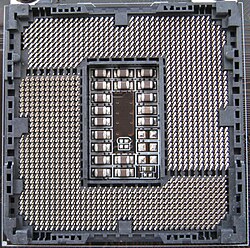Socket 1155
| Socket 1155 | |
|---|---|

|
|
| Specifications | |
| introduction | 2011 |
| design type | LGA |
| contacts | 1155 |
| Bus protocol | Direct Media Interface (DMI) |
| Processors |
Intel Core i Series 2 Intel Core i Series 3 |
The Socket 1155 (also known as LGA1155, FCLGA1155 or Socket H2) is a processor socket for the processor series Intel Core i3 , Core i5 , Core i7 and Intel Celeron dual-core of Sandy- and Ivy Bridge generation. It was introduced in January 2011. The 1155 socket was replaced by the 1150 socket in 2013 .
It is the successor to the base 1156 . This base became necessary when the Sandy Bridge architecture replaced the Nehalem micro- architecture . In the case of processors for the 1155 socket, the memory controller and the PCIe controller are still integrated in the processor - the socket provides the corresponding connections.
The biggest change compared to its predecessor is the separate connection of CPU, IGP and the integrated Northbridge to their own power supply with the 1155 socket. The chipset, which consists of a chip (formerly Southbridge), is connected via DMI . Compatible chipset series for this socket are the Intel 6 series and the Intel 7 series .
Sandy Bridge chipsets
Information on compatible chipsets can be found in the table below. Intel has decided not to integrate a connection option for USB 3.0 ports in their chipsets. The H67 platform has supported USB 3.0 and SATA 6Gb / s since revision B3.
| P67 | H67 | H61 | B65 | Z68 | |
|---|---|---|---|---|---|
| Supported CPU | Sandy Bridge LGA-1155 |
Sandy Bridge LGA-1155 |
Sandy Bridge LGA-1155 |
Sandy Bridge LGA-1155 |
Sandy Bridge LGA-1155 |
| PCIe configuration | 1 × 16 or 2 × 8 PCIe 2.0 | 1 × 16 PCIe 2.0 | 1 × 16 PCIe 2.0 | 1 × 16 PCIe 2.0 | 1 × 16 or 2 × 8 PCIe 2.0 |
| DDR3 slots | 4th | 4th | 2 | 4th | 4th |
| Overclocking CPU | Yes | No | No | No | Yes |
| Overclocking from IGP | No | Yes | Yes | Yes | Yes |
| IGP usable | No | Yes | Yes | Yes | Yes |
| RAID support | Yes | Yes | No | Yes | Yes |
| USB 2.0 ports | 14th | 14th | 10 | 12 | 14th |
| SATA 2.0 / 3.0 ports | 4/2 | 4/2 | 4/0 | 4/2 | 4/2 |
| PCIe lanes | 8 (5 GT / s) | 8 (5 GT / s) | 6 (5 GT / s) | 8 (5 GT / s) | 8 (5 GT / s) |
Ivy Bridge chipsets
With the Ivy Bridge series update, connection options for PCIe 3.0 and USB 3.0 were added. The Series 7 chipsets are backwards compatible with Sandy Bridge CPUs, but the PCIe 3.0 slots then run in PCIe 2.0 mode.
| B75 | Q75 | Q77 | H77 | Z75 | Z77 | |
|---|---|---|---|---|---|---|
| Primary PCIe configuration | 1 × 16 | 1 × 16 | 1 × 16 | 1 × 16 PCIe 3.0 | 1 × 16 or 2 × 8 PCIe 3.0 | 1 × 16 or 2 × 8 PCIe 3.0 or 1 × 8 PCIe 3.0 + 2 × 4 PCIe 3.0 |
| Secondary PCIe | 1 × 8 PCIe 2.0 | 1 × 8 PCIe 2.0 | 1 × 8 PCIe 2.0 | 1 × 8 PCIe 2.0 | 1 × 8 PCIe 2.0 | 1 × 8 PCIe 2.0 |
| DDR3 slots | 4th | 4th | 4th | 4th | 4th | 4th |
| Overclocking CPU | No | No | No | No | Yes | Yes |
| Overclocking from IGP | Yes | Yes | Yes | Yes | Yes | Yes |
| IGP usable | Yes | Yes | Yes | Yes | Yes | Yes |
| RAID support | Yes | Yes | Yes | Yes | Yes | Yes |
| USB 2.0 / 3.0 ports | 8/4 | 10/4 | 10/4 | 10/4 | 10/4 | 10/4 |
| SATA 2.0 / 3.0 ports | 5/1 | 5/1 | 4/2 | 4/2 | 4/2 | 4/2 |
| PCI | Yes | Yes | Yes | Yes | No | No |
| Intel Rapid Storage Technology | No | No | Yes | Yes | Yes | Yes |
| Smart Response Technology | No | No | Yes | Yes | No | Yes |
Individual evidence
- ↑ intel.de - Installation and integration for LGA1155 socket-based processors® desktop processors , accessed on January 27, 2020
- ↑ anandtech.com - The Sandy Bridge Preview
- ↑ intel.com - Ivy Bridge Sockets 1155
- ↑ REV 3.0 - New H67 B3 revision Intel® H67 platform /. In: asus.com. Retrieved January 2, 2018 .
- ↑ Archived copy ( Memento of the original from July 18, 2011 in the Internet Archive ) Info: The archive link was inserted automatically and has not yet been checked. Please check the original and archive link according to the instructions and then remove this notice.
- ↑ anandtech.com - Intel's Roadmap: Ivy Bridge, Panther Point and SSDs